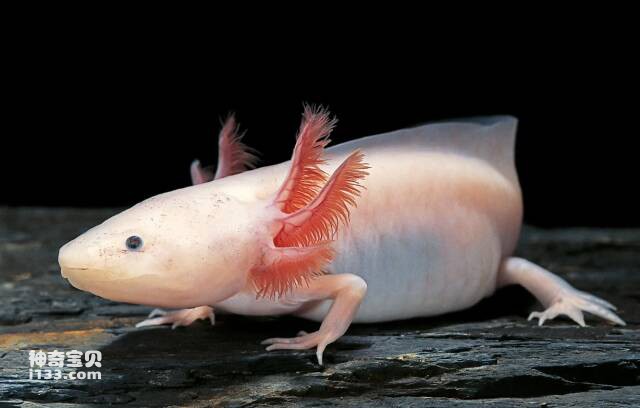Mexican axolotl (scientific name: Ambystoma mexicanum, English: Axolotl), also known as "axolotl", commonly known as "hexagonal dinosaur", is an aquatic amphibian and endemic to Mexico. Because of its unique appearance and small size Famous for its continuation. In other words, even after sexual maturity, it will not undergo metamorphosis to adapt to land, but will still maintain its aquatic larval form. The "ageless appearance" of the Mexican axolotl has made it the subject of research by many scientists. Although they are kept as pets around the world (especially in North America and other places), their original habitat has been heavily exploited, and the living area is no more than 9 square kilometers. The native species is currently rated as critically endangered on the IUCN Red List.

There are more than 30 strains of Mexican axolotl. The following are common types on the market, including improved types:
Albino Hexagonal Dinosaur: It is the most commonly seen species on the market. As the name suggests, its appearance is completely milky white and its outer gills are red. It is generally called an albino black-eyed dinosaur. However, some may have black horns and some black spots on their bodies.

Albino Hexagon: The color is similar to that of the Albino Hexagon, but the eyes are red and the outer gills are a little orange. Commonly known as white eyes and red eyes, dark spots rarely appear on the body.
Black Hexagonal Dinosaur: Metaplasma color species, due to research and improvement, black individuals have become rare individuals, and the outer gills are mostly black or purple-black. Commonly known as dark blue, when young, it will reflect blue light under light. Black ones are better and shiny. Usually there are few black spots on the body (it can only be seen under strong light), and it looks more pure black.
Gold foil hexagonal dinosaur: The body is covered with bright white spots like gold flakes, and the outer gills are also red. It is the brightest color among the hexagonal dinosaurs. Common gold foil strains include luteal gold foil (yellow body color) and platinum gold foil (white body color), all of which have gold foil distributed on the body.
Tiger-spotted Hexagonal Dinosaur: The body color is khaki with black at first glance, but if you look closely, it is dark green, almost black under no light, with black spots all over the body, and the outer cheeks are dark red; while the wild species of Tiger-spotted Hexagonal Dinosaur are The critically endangered species on the IUCN Red List of its native Mexico are also relatively rare on the market.
The following are uncommon strains on the Taiwan market, including improved types:
Hexagonal dinosaur with gold foil on black background: Metallic golden spots are all over the body, which will gradually become larger, brighter and clearer as it grows. Pure black base, most of the horns are covered with golden spots, and the gills are black. Commonly known as the golden leopard, the yellow-backed black spots are similar to tiger spots when young, but more golden. As they grow older, they become more obvious and different from the tiger-spotted hexagonal dinosaur.

The following are special individuals and performances on the market, which are not yet stable strains:
Hexagonal dinosaur with irregular black spots on a white background/yellow background: There are pure black irregular color patches of different sizes all over the body. Sometimes only one part has black lines, so some people say it looks like splashing ink or a cow. It is usually light-colored. The bottom and gills are mostly red.
Irregular green-spotted hexagonal dinosaur on a yellow background/white background: The body is pure green spots, or green with black spots. Irregular color patches of different sizes are scattered all over the body, because the green spots on the yellow background are easily reminiscent of seaweed cheese, and the white ones are The black and green spots on the bottom are seaweed rice balls, so some people call it seaweed.
Hexagonal dinosaur with irregular yellow spots on a white background: The body is pure yellow, irregularly distributed, with a white background, red eyes, and a slightly pink body. Therefore, some people call it the pink leopard or milk flower.
Short-bodied hexagonal dinosaur: It has a big head and a small body, and its body features are rounder. It is half shorter than other general hexagonal bodies. It will be smaller when it reaches adulthood, so some people call it a dwarf.
Hexagonal dinosaur with heterochromatic pupils: its eyes are of different colors, one black and one red. Because it is very rare, some people call it heterochromatic pupils or yin and yang eyes.
Yellow-backed and white-bodied hexagonal dinosaur: The upper half of its body is bright pure yellow, the lower half is white, with red eyes and orange cheeks. The tail is covered with gold and platinum and is scattered in other places. It is as bright as an emperor's robe, so some people call it a performance For the golden dragon robe.
Yin-Yang Hexagonal Dinosaur: The body color is very symmetrically divided into two halves, and sometimes the eyes may be half black and half red.
Dragon-horned Hexagonal Dinosaur: The six horns are like antlers and branch out, very magnificent.
animal tags: axolotl
We created this article in conjunction with AI technology, then made sure it was fact-checked and edited by a Animals Top editor.